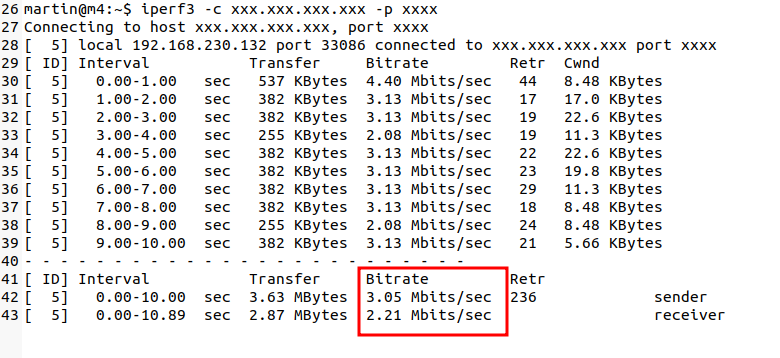
When I was recently in North America, I didn’t only have a look at the terrestrial networks there, but I was also looking forward to test Delta Airline’s on-board Internet connectivity over the Atlantic. In the past, I had mixed experiences with on-board Internet, and I had the impression that before Covid, on-board Internet was slowing down over the years. So how would connectivity work this time? The screenshot on the left already gives a first indication.
So let’s talk about the good things first. While over the Atlantic, I could get datarates of well over 20 Mbps in the downlink direction when running iPerf tests. The 12.8 Mbps shown in the screenshot above are hence somewhat of an understatement. The screenshot above, however, shows two other interesting things: The round trip delay time over the Atlantic was 811 ms, a normal value for a satellite connection. Furthermore, the screenshot shows the IP address ‘of the plane’, which belongs to Intelsat. That’s interesting because there are quite a number of satellite providers offering on-board Internet, and this shows that Delta uses Intelsat over the Atlantic. Spoiler: Over the North American continent, Delta uses a different satellite network, but that’s something for the next post.
Back to the iperf measurements, here are screenshots of downlink and uplink speed measurements:

And here’s the corresponding uplink measurement:

Particularly in the downlink direction, the datarates during most of the flight exceeded my expectations, and I could use all tools and services I would use ‘on the ground’ for my daily work with a noticeable but quite acceptable lag: Web browsing obviously worked, ssh worked, OpenVPN worked, and I could stream Youtube videos as well. Apart from local document editing, I use an Online Office suite that runs on servers in Germany and Finland, and editing documents in the web browser worked nicely as well. The final test: Running a VNC / RDP screen sharing session over the link. While sharing worked well, it was a bit painful to use due to the high round trip delay. But still, I was surprised that it was usable at all. Another interesting data point was the packet loss rate. Out of 1211 pings, I got 57 fails, which is around 4.7 per cent. Not stellar, but not an issue at all.
So while things worked well for most of the flight, I noticed a significant slow down once we reached the North American continent. For the last two hours of the flight, downlink throughput decreased to around 2 Mbps and round trip times increased to around 900 ms. So either I ran into a volume cap, or the network was more congested over over the North American continent, or more people started using the services towards the end of the flight. At this speed, pretty much all services I use for my daily work started to show a significant lag. I could still use my online office, but the initial loading of documents took a significant amount of time. Once loaded into the browser, however, I could work on the documents just fine, as all the rendering is done locally in the browser.
As I wanted to use Internet connectivity with several devices, I used Wi-Fi tethering to connect my PC and a second phone to the smartphone which I had connected via Wi-Fi to the on-board Internet. For reasons unknown, this didn’t work so well at first and devices either didn’t connect to my smartphone hotspot at all or only after a long time. And once connected, throughput was pretty slow. I then switched the Wi-Fi hotspot on my smartphone to the 6 GHz band and things immediately and significantly improved. A bit strange. Another option I tried was USB tethering from the smartphone to my notebook for Internet connectivity and this also worked without any issue. A nice side effect of this is that I could charge my smartphone over USB while working on the notebook.
And one more interesting learning during the flight: One of my smartphones refused to share the Wi-Fi connection over Wi-Fi while cellular connectivity was deactivated. That’s kind of stupid. My other device from a different manufacturer, however, had no such restrictions and happily shared my Wi-Fi connection over Wi-Fi tethering again. Makes me wonder if this is an oversight or has been done on purpose by the manufacturer of the first device. No way of telling.
So overall, I was very happy with the on-board Internet service during the flight over the Atlantic, kudos to Delta and Intelsat!